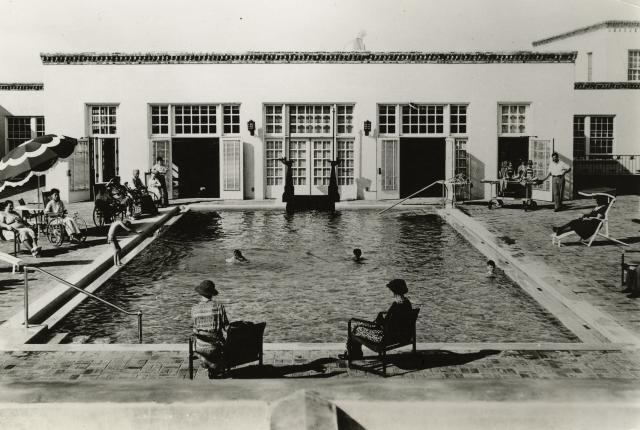THE OPENING OF A ROADSIDE HOT SPRINGS might not seem like an occasion for tears. But when the mineral baths on NM 65 outside Las Vegas, New Mexico, reopened last fall after 18 months of Covid-related closure, Friends of Montezuma Hot Springs President Martín Leger wept. The nonprofit group’s new partnership with United World College–USA, which owns the land where the springs are located, gives the community a greater stake in the historic springs than ever before.
A photo exhibition at the New Mexico History Museum, in Santa Fe (March 18–September 4), aims to explore the complex issues surrounding hot springs in New Mexico—their origins and expansions, as well as questions of ownership and entitlement. Curative Powers: New Mexico’s Hot Springs—a show of 90 photographs and vintage maps, brochures, and other promotional materials—grew out of an “investigation of a natural phenomenon that occurs in various parts of the state,” says Curator of Nuevomexicana/o History Alicia Romero.
Contemporary and historical photos tell the nuanced story of hot springs tourism. As Romero recounts, many plots that included geothermal features were snapped up and privatized after the American takeover of New Mexico. For instance, Montezuma Castle, now the site of UWC–USA and the adjacent springs, was originally built by the Atchison, Topeka & Santa Fe Railway as a luxury hotel to capitalize on hot springs enthusiasm, including tuberculosis patients who sought the water’s healing properties. The progression of photos through time highlights the growing infrastructure surrounding the state’s mineral watering holes, as well as changes in the types of visitors to them.
“The ownership of these hot springs can determine their patronage,” says Romero. She points to the contrast between the boutique spa experience offered by Ojo Caliente Mineral Springs Resort & Spa and the free hot springs available to hikers in the Jemez National Forest. “Who has been able to access these natural healing experiences historically?”
Romero says at least one notable photo in the exhibit shows a group of late-19th-century tourists: unsmiling men and women, seemingly just off a train, in hats and long tails and buttoned-up dresses, carrying parasols. “These people are just kind of sitting at the hot spring in their beautiful Victorian clothing,” Romero says. Less than a century later, many pictures from the 1970s depict the hippie invasion of mineral baths. “They go from fully clothed to no clothes,” she laughs, describing the more daring generation who frolicked in steamy springs from Taos to the Gila National Forest.
Though the rules may have changed, the draw remains. These days, a line of cars park along NM 65 in Montezuma every weekend to visit the community-tended springs. “They mean so much to so many of the local people here,” says Leger. “Their parents and their grandparents have all soaked. It’s a place of healing and contemplation, and really being able to be one with the water, one with the sky, one with the earth.”
Curative Powers: New Mexico’s Hot Springs
New Mexico History Museum
March 18–September 4
113 Lincoln Ave., Santa Fe; 505-476-5200


